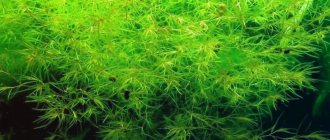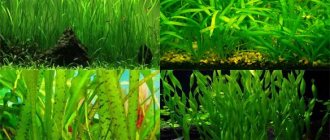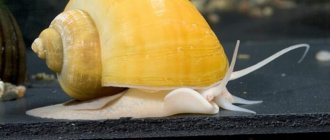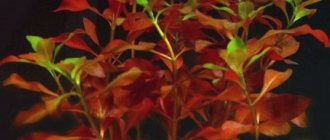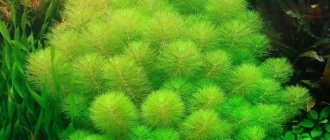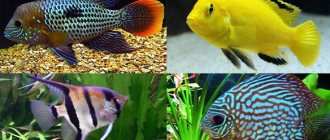Riccia is a bryophyte plant that is often used in aquariums. In the wild, most species grow near ponds and other wet areas. There are also swimming species.
Habitat: stagnant or slow-flowing bodies of water in warm temperate climates.
Without greenery, an aquarium looks boring. In addition, plants can be useful for fish and other inhabitants: they saturate with oxygen, maintain optimal water quality, act as food, etc.
What everyone should know about Riccia in the aquarium
Riccia can be found in almost every corner of the Earth. This plant has a completely different structure than most aquarium plants. Riccia floating is a beautiful plant that can be used to decorate the bottom of an aquarium, artificial shading or feeding fish.
The plant grows quickly in comfortable conditions and is capable of forming a carpet 2-3 cm thick in a short time. Riccia is useful for fish that love the dark, since, floating above the water, it does not allow daylight to penetrate into the aquarium.
Advice for amateurs
Despite the ease of care, there are some points that are worth paying attention to so that Riccia brings exceptional benefits:
- The plant should be located away from the feeder so that food debris does not clog the moss;
- The thickness of the thallus should be no more than 3 cm (the lower layer will die and the upper layer will separate), trimmed every week;
- After weeding, the broken parts can be used as an additive for other aquarium plants. To do this, they need to be dried, crushed and mixed with clay. Then roll the balls and place them on the roots;
- Particularly active growth occurs in the summer. If Riccia has grown greatly, it is necessary to lower the temperature to 20°;
- Keep the lid of the aquarium covered, otherwise the floating Riccia will begin to grow beyond its limits, striving for warm and humid air.
Popular types
More than 60 varieties of Riccia are known. They are all similar to each other and have slight differences. External signs also do not affect the conditions of detention. These are some of the plants that are easy to care for:
| It grows naturally in North America and Western Europe. Moss forms “humocks”, the height of which can reach 10-15 cm. Riccia has a thick shoot of bright green color. The plates are slightly elongated, up to 1 mm wide. The branching distance is no more than 1 cm. It can grow on the bottom and surface of the aquarium, but more often it shows its beauty on the surface. |
| The peculiarity of this riccia is that it is dwarf. It lives on the bottom and easily establishes itself, forming net thickets. The plant is especially loved by designers who experiment with the shapes of moss using scissors. |
| The algae grows on submerged surfaces because it has a sinking effect. It differs from others in that it has a dark green color, long branches and grows slowly. Plant height 1-5 cm. Width 3-5 cm. |
| This is the most common type. With the help of air cavities that appear inside, the plant floats on water. |
Description of the plant
Riccia belongs to the Liver moss family. It has no roots, stems or leaves. The algae consists of small green stems and plates intertwined with each other. Inside the branches there are cavities filled with air, which lift them to the surface of the water. There are plates on the stems. On the inside they are covered with a thin cuticle impregnated with a protective waxy substance. The root system is rhizoids - thread-like outgrowths, thanks to which the algae receives nutrients and substances and attaches to surfaces.
As the plant grows, it forms a dense carpet on the surface of the reservoir, called thallus. Over time, its thickness can reach several centimeters.
Under favorable conditions, the algae has a bright green color. During the period of wilting or lack of nutrients, it turns dark green or reddish brown.
Also, a change in color occurs during the maturation of spores, which can persist not only in a humid environment, but also during periods of drought, when adult plants die. In the rainy season, when reservoirs are filled with water, Riccia forms a young green mass.
Maintenance and care
It is not difficult to maintain Riccia - it adapts well to any conditions, which is what has allowed it to spread so widely. If the following indicators are violated, you may die and change your appearance:
- Lighting. The light should be bright. Incandescent lamps are not suitable, as they heat the water and dry out the plants, so it is better to use fluorescent lamps located on top (2 W per 10 cm).
- Water and volume of the aquarium. The water needs to be changed regularly. Due to cloudiness of the water, metabolic processes are disrupted, so about 20% of the water needs to be changed every week. Since Riccia grows strongly, the volume of the aquarium for its maintenance should be from 10 liters. When the water hardness is 14°, the plant develops poorly; it is better to use softer water.
- Don't forget about regular haircuts. If this is not done, then due to the dense carpet of algae, a small amount of oxygen will flow. It is best to rinse the aquarium after cutting.
How to plant
Since the plant does not have a root system, it is unable to take root in the soil on its own. Therefore, aquarists often resort to various kinds of tricks in order to make Riccia creep along the bottom. After growth, the fastening can be removed - by that time the plant can independently grow into the relief elements. There are several options for planting Riccia:
Carpet
For this purpose, mesh, fishing line or nylon are used. Pull the branches through the mesh, cover the rest completely. You can also prop up the mesh for better stability. These could be stones in the aquarium and other decorative items.
On a snag or stone
Having initially secured the weight inside, Riccia can be planted in a net. It is important to pre-treat all jewelry in a saline solution. If everything is ready, plant the plant there. The technique is the same: use fishing line or mesh.
Island on the water
You need to tie large balls of moss together with a thread, and the plant itself will hold on and grow on the water.
Reproduction
In order for the plant to begin to reproduce, it is enough to place a twig in water at least 15-20°C, which is not broken anywhere.
And after 15 days the aquarium will be covered in fluffy piles of moss. You can also try the vegetative propagation method. To do this, place a small piece of the plant in a separate container with clean and settled water. As soon as the plant grows, it can be moved to a community aquarium.
What benefits can it bring:
- enriches water with oxygen;
- the biochemical indicator of water becomes better;
- creates a refuge for aquarium inhabitants;
- material for building nests of different types of fish;
- the place where ciliates reproduce is a source of food for aquatic inhabitants;
- food for turtles and shellfish;
- Shading design for fish that do not tolerate bright light.
Like most green plants, Riccia floating has a beneficial effect on the balance of the aquatic environment. Floating grass removes harmful decay products, toxins, ammonium from the liquid, and saturates the water with oxygen.
What fish eat Riccia
The plant is used as a food supplement for large herbivorous aquarium inhabitants, but more often it serves as a spawning substrate for labyrinth fish.
Riccia branches are quite tough, so not all fish can pinch off pieces from it. More often, fish are attracted to rhizoids and microorganisms living in its thickets.
Fish often use its plates to build nests, and spawning fish lay their eggs on twigs, providing future offspring with a source of nutrition and an oxygen-rich environment.
Why isn't it growing?
For Riccia, the presence of even a small admixture of table salt and its derivatives in the water is detrimental.
Slow growth:
- Due to the high hardness of the water or a small amount of it, Riccia can grow slowly; another reason is cold water. The plant disintegrates and does not form decorative branches.
- Turbidity of water and its pollution. The water in the aquarium needs to be changed more often.
- The separation of moss into individual branches occurs in poor lighting. A white coating forms on the surface.
Riccia is a very unpretentious plant, but difficulties can always arise during breeding. The best time of year for growth is summer.
Peculiarities
The growth of Riccia is seasonal and is associated with the cycles of rain and drought in the tropics. Even under the most ideal conditions, the plant periodically changes its color from rich green to dark brown and begins to fade. At this time, it actively forms spores that are practically invisible to the naked eye. These disputes subsequently give life to new shoots of Riccia.
In good conditions, Riccia often bubbles, which makes this plant decorative and at the same time helps saturate the aquarium with oxygen. If you want to stimulate the process of bubble formation, CO2 fertilization and increased lighting are recommended. But it must be remembered that many bubbles filling the inner space of Riccia’s weaves can cause the plant to float.
Fertilizers for Riccia
To maintain the desired microclimate, you need to observe the “behavior” of Riccia after it is placed in the aquarium. Some moss leaves may break off and float to the top. They can grow just as much as at the bottom. If you do not take care of this and do not clean the aquarium, it will be difficult for other fish to move, and soon the aquarium inhabitants, including Riccia, will begin to die due to lack of light.
Underwater Riccia can be capricious: you need to purchase additional fertilizing and mineral fertilizers, and you will also need to saturate the water with CO2. After which you can enjoy the view from thousands of air bubbles on algae branches.
Possible problems during cultivation
If any important maintenance rules are not followed, the aquarist may encounter some problems in breeding Riccia.
We recommend learning how to keep Java moss in an aquarium.
Disintegrates
As noted above, this type of moss is very demanding in terms of lighting. Properly organized light over the aquarium will protect the green mat from rotting and possible disintegration into twigs.
Doesn't grow
The problem of slow or stopped growth of Riccia lies in incorrect temperature parameters. When the indicator drops below +20 °C, the growth of the island will slow down sharply, and within a couple of weeks the plant may be in danger of death.
Versatility of use
We can say that this is a very beautiful and multifunctional plant that does not require attention. Riccia creates the right environment, serves as a natural light filter for fish and provides food for fry and turtles.
To understand how to decorate an aquarium, you should know which plants it looks best with:
- a continuous carpet of riccia effectively sets off the beauty of colored hybrid echinodorus planted in the background or directly on the green “carpet”;
- very beautiful single stones or groups of stones, overgrown with riccia, between bunches of hemianthus micranthemoides and in clearings of lileopsis brasiliensis;
- in aquascaping, a lawn consisting of glossostigma povoinichina, floating riccia and dwarf eleocharis is often planted:
- Riccia looks great in composition with other types of aquarium mosses.
Riccia can be used as food for some animals. If some fish don’t like it, then turtles and other mollusks will definitely not swim past an excellent dessert.
We can say that this is a very beautiful and multifunctional plant that does not require attention. Riccia creates the right environment, serves as a natural light filter for fish and provides food for fry and turtles.
